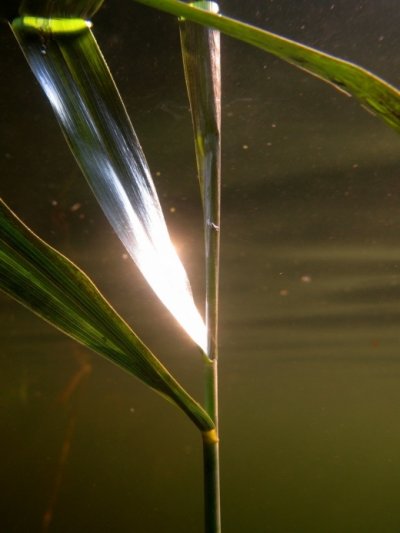Photosynthesis in completely submerged wetland plants is severely impeded by low light, and the slow diffusion of CO2 across the aqueous diffusive boundary layer (DBL) adjacent to leaves. Aquatic and amphibious plants have evolved a number of leaf traits to reduce the total resistance to CO2 uptake, including: (i) dissected leaves, (ii) undulating leaf edges to increase turbulence across the leaf, (iii) thin leaves, (iv) reduced cuticle, and (v) chloroplasts in epidermal cells. The first three traits (i, ii & iii) all serve to erode/reduce the DBL and thus decrease the distance of molecular diffusion (i.e. decreased total external resistance to CO2 uptake), and (iv & v) reduce the resistance within the tissue for the diffusion pathway to chloroplasts. Likewise, many submerged terrestrial wetland plants also display some acclimation to inundation such as thinner leaves, reduced cuticle and chloroplast orientation towards the source of CO2. Amphibious plants are positioned between the truly aquatic plants and the terrestrial wetland plants and display a suite of leaf acclimation traits that allows efficient gas exchange by leaves in air, as well as those formed under water.
Rates of net photosynthesis by submerged leaves are typically much lower than rates achieved in air, even for acclimated leaves. Underwater net photosynthesis by submerged terrestrial plants is generally lower than the rates achieved by aquatic plants. However, this is only true when photosynthetic rates are expressed on a per unit area basis, the units commonly used in terrestrial plant physiology. When net photosynthesis is expressed on a per unit dry mass basis, rates in aquatic plants > amphibious plants > terrestrial plants and this order reflects the higher carbon-return per unit of dry mass investment by the aquatic leaf types, as compared with terrestrial leaf types, when submerged.
Gas films on leaves of submerged terrestrial wetland plants have also been shown to facilitate underwater photosynthesis. Gas films form on hydrophobic leaf surfaces of many wetland plants when submerged (Figure 18.15); e.g., species of Phragmites, Typha, Spartina, Carex, Phalaris and Oryza (including cultivated rice), and the gas film forms a large gas-water interface that facilitates gas exchange with the surrounding water.
It is likely that the stomata remain open underneath the gas film. The gas films enable leaves of such terrestrial wetland plants to photosynthesize under water, albeit at rates much reduced when compared with in air, but without further acclimation and this strategy may therefore be particularly advantageous under short floods; as examples, frequent tidal submergence or short duration flash floods such as in some rice-growing areas and natural wetlands where water recedes after a week or two. The improved O2 and sugar status of submerged rice owing to the beneficial effects of leaf gas films would enhance survival during complete submergence.
